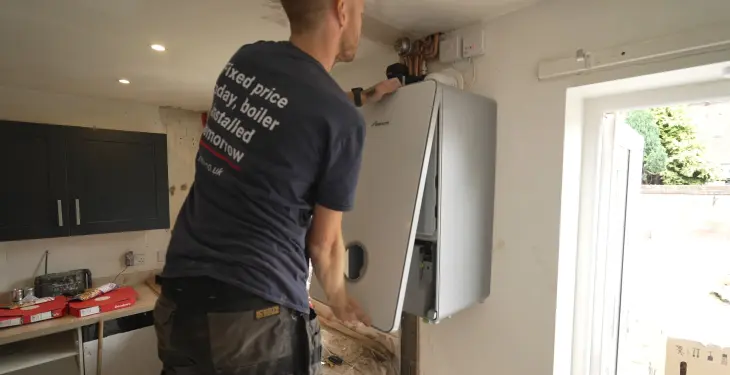

Written by Stephen Day
Gas Safe Engineer
Updated: 30th May, 2025
Boiler error codes are a critical feature intended to assist in the diagnosis of issues within your heating system. These alphanumeric codes display on the boiler's control panel, guiding users and service engineers to the root of a problem.
Get a new boiler quote, save up to £550 per year (0% APR available).
Glow Worm boilers, renowned for their efficiency and reliability, occasionally encounter a perplexing issue: the boiler fails to fire up without displaying any fault code. This situation can be particularly baffling because fault codes are designed to diagnose problems swiftly.
Homeowners and engineers rely on these codes to identify issues and implement the appropriate fixes. Without a fault code, the path to a solution isn't straightforward, and it leaves users uncertain about the next steps to take in troubleshooting their heating system.
Understanding why a Glow Worm boiler might not ignite without showing a fault code involves considering several factors. It's important to check simple potential causes such as power supply, gas supply, or pressure issues before proceeding to more complex diagnostics.
Sometimes, an intermittent glitch might prevent the boiler from firing up, even though all components are functioning properly. When the usual indicators fail to pinpoint a problem, it could also be a sign of a subtle fault that requires professional diagnosis.
Boiler error codes are a critical feature intended to assist in the diagnosis of issues within your heating system. These alphanumeric codes display on the boiler's control panel, guiding users and service engineers to the root of a problem.
Boiler error codes are specific combinations of numbers and, occasionally, letters, that appear on the digital display of a boiler when its internal diagnostics detect a fault or irregularity. Each code corresponds to a particular issue, ranging from minor operational glitches to critical system failures. For example, a code might indicate a problem with the boiler's ignition system, signifying that it's not firing up, all without showing a visible fault code.
Recognising the significance of these error codes is essential for maintaining central heating systems effectively. They act as the first indicator of a potential issue, allowing homeowners and technicians to take proactive steps before a minor fault escalates into a significant problem. Furthermore, a clear understanding ensures timely troubleshooting, which can save both time and money on unnecessary repairs. Error codes also facilitate better communication between the homeowner and professional, ensuring more efficient and precise service encounters, should a Gas Safe engineer need to be involved.
When a Glow-worm boiler fails to fire up and does not display a fault code, homeowners may find themselves in a perplexing situation. Initial checks should include verifying the boiler's gas supply, as a fundamental issue such as a closed gas valve could be the cause. Additionally, reassessing the boiler's pressure is crucial; it must align within the manufacturer's stipulated range for optimal operation.
Should these basics be in order, it could imply the presence of a more nuanced problem. For example, components such as the ignition system might be malfunctioning without triggering a diagnostic code. The absence of hot water and heating despite adequate pressure points towards an internal issue that an engineer may need to investigate further.
A brief inspection of the electrical connections is advised to ensure they are secure, as loose wires could disrupt the boiler's functionality. However, if the boiler exhibits intermittent operation—where it heats momentarily before ceasing—this erratic behaviour might suggest a compromised heat exchanger or issues with the internal pump or flow sensors.
Listed below are some steps an owner can take before seeking professional assistance:
Ensure the gas supply: Check that the mains supply is on and the gas valve is open.
Boiler Pressure: Examine whether the boiler pressure is within the safe operating range.
Electrical connections: Inspect for loose connections that might affect the system starting.
Engaging the services of a certified engineer is recommended to perform comprehensive diagnostics and to address any underlying issues safely and correctly. The intricacies involving a boiler, especially when no fault code is present, demand a methodical approach to isolate and rectify the root cause.
When a Glow-worm boiler fails to fire up without displaying a fault code, troubleshooting becomes a matter of careful analysis of symptoms and understanding common causes related to this type of boiler malfunction.
Glow-worm boilers are designed to present specific error codes, like F22, F28, and F29, which indicate particular issues within the system. However, the absence of these codes can suggest a more complex situation.
F22: This code usually indicates low system water pressure, requiring the water pressure to be topped up.
F28: Signals an ignition failure, meaning the boiler is unable to light the burner after multiple attempts.
F29: Points to a flame detection fault, where the boiler can ignite but is unable to detect the flame once lit.
Although no fault code is displayed, the boiler experiences what one would expect from these errors—a breakdown in the sequence from ignition to flame detection and stability.
A Glow-worm boiler not firing up with no fault code might be attributed to several factors:
Blocked Plate Heat Exchanger: The transfer of heat could be hindered, preventing operation.
Stuck or Damaged Diverter Valve: Essential for directing hot water, if stuck, the boiler may cease to function.
Faulty Temperature Sensor: Without accurate temperature readings, the boiler may fail to start.
Broken Flow/Micro Switch: This switch signals the need for heat; if broken, ignition won't occur.
In the absence of specific fault codes, each potential reason requires thorough investigation. Typically, a heating engineer would approach the issue methodically, testing each component's functionality to identify the root cause of the boiler's failure to fire up.
When a Glow-worm boiler fails to fire up without displaying a fault code, it can be perplexing; however, there are steps homeowners can take to troubleshoot the problem.
Repressurising the Boiler: If the pressure gauge indicates low pressure, homeowners should attempt to repressurise the system to around 1.5 bar. This often involves manipulating specific valves and can be guided by the boiler manual.
Signs of Air in the System: Should there be gurgling sounds emanating from the radiators or pipes, it may be indicative of air trapped within the system. Bleeding the radiators to release the air might rectify the heating issue.
Unfreezing the Condensate Pipe: During winter, a frozen boiler condensate pipe is a common cause of boiler malfunction. Carefully applying a hot water bottle or warm cloths to the pipe can thaw the blockage and start the boiler.
Safety First: It is imperative that homeowners do not attempt repairs that involve removing the boiler cover, as this should only be undertaken by a Gas Safe registered engineer. Any service or repairs that delve into the boiler's internal components present a risk and could void the warranty.
When to Call a Professional: If after the basic DIY checks the boiler still fails to operate, it's advisable to seek expert help. Complex issues, such as problems with internal components or persistent error codes, require professional diagnostics and repairs. It ensures services are performed safely and up to standard.
If your Glow-worm boiler is not firing up and there's no fault code, it's essential to determine whether you need expert intervention. Tackling gas boiler issues without proper training can be dangerous.
Occasionally, a Glow-worm boiler may not activate due to simple matters such as a tripped fuse or an inadvertently closed gas valve, which homeowners can safely check. However, if basic checks do not resolve the issue, it's vital to contact a Gas Safe registered engineer to inspect the boiler. Should the boiler exhibit symptoms like a gas smell or you're unable to pinpoint the problem, professional assistance is imperative. Moreover, annual service by a certified engineer is recommended to maintain the appliance's efficiency and safety.
Gas Safe registered engineers are certified professionals who have the qualifications to work on gas installations legally and safely in the UK. These engineers must pass rigorous assessments covering all aspects of gas safety. Engaging a Gas Safe engineer ensures that any boiler repairs or installations adhere to the strict standards set by UK legislation. Their expertise is crucial, not just for legal compliance but for guaranteeing the safety of your household while addressing complex issues, such as those possibly affecting a malfunctioning boiler.
When a Glow-worm boiler refuses to ignite and no fault code is displayed, homeowners may find themselves worrying about the potential costs involved in getting their system up and running again.
The cost to address a Glow-worm boiler ignition problem with no fault code typically ranges from £50 to £250. This estimate is derived from common field scenarios, acknowledging how repairs are either straightforward or complex. For instance:
Minor adjustments or fixes: Low end of the price spectrum (around £50)
Replacement parts or labour-intensive repairs: Higher end of the price spectrum (up to £250)
Several factors can influence the final price of repairs:
Type of repair: Simple resets are cheaper, whereas part replacements or wiring issues can cost more.
Boiler model and age: Older boilers or discontinued models may incur higher repair costs due to part scarcity.
Location: Labour costs vary across the UK, potentially affecting the overall expense.
Time of repair: Emergency callouts or weekend services often command higher fees.
Whilst the general repair quotes offer a basis, it's prudent to obtain personalised estimates from licensed professionals, who can consider the intricacies of the Glow-worm boiler and provide an accurate price. Should the repair exceed the value of the boiler, it may be more cost-effective to invest in a new boiler and installation, the cost of which spans a much broader range.
Identifying whether a boiler needs repairing or replacing can be complex. This section provides the criteria for that decision and an overview of boiler lifespans.
When a Glow-worm boiler ceases to fire up and displays no fault code, several factors determine if it can be repaired or needs replacing. It is crucial to consider:
Age of the Boiler: If the boiler is approaching or has exceeded its typical lifespan, which averages 10 to 15 years, replacement may be a more cost-effective solution.
Frequency of Breakdowns: Regular malfunctions not only increase costs but also indicate the boiler may be beyond practical repair.
Cost of Repairs: Should the cost of repair be substantial, obtaining a new boiler with a fresh warranty from the Vaillant Group becomes a more sensible choice.
Efficiency Levels: An older boiler's efficiency deteriorates over time; if a boiler is not operating effectively, replacing it would ensure better performance and lower energy bills.
Availability of Parts: Difficulty in sourcing parts for older models can mean that replacement is the only viable option.
A boiler's lifespan plays a significant role in the decision to repair or replace it. Glow-worm boilers, part of the Vaillant Group, typically offer:
Standard Lifespan: An expected functioning period of between 10 to 15 years, assuming routine maintenance and services are adhered to.
Warranty Period: Warranties usually range from 2 to 7 years, with some boilers eligible for up to 15 years through specific installer networks. If a boiler is out of warranty, the incentive to replace, particularly with a more efficient model, increases.
Signs of Ageing: As boilers age, parts wear out, and their overall performance decreases. If boilers are maintained annually, it helps ensure safe operation and may extend the boiler's life. Yet, once a boiler shows persistent issues beyond its anticipated lifespan, replacement is frequently the more reliable long-term option.
When contemplating whether to repair or replace your Glow-worm boiler, if the system is reasonably new and the cost of repair is low, repair may suffice. However, as the unit ages and costs escalate, investing in a new, energy-efficient boiler can be the wiser economic and practical course of action. Installation of a new boiler should always be carried out by a qualified engineer to guarantee safety and efficiency.
When addressing Glow-worm boiler ignition issues without a displayed fault code, one must consider several factors. First, it is essential to verify the gas supply, as obstructions or closure of the main valve can impede boiler function. Additionally, checking the power source is vital; a tripped circuit breaker or a blown fuse could easily be the culprit behind the lack of ignition.
Commonly overlooked yet simple to remedy, air pressure switches may malfunction, preventing the boiler from firing up. To address this, ensure the switch is clean and devoid of blockages. One should also inspect the condensate pipe; during unforgiving winter months, it could freeze, causing the boiler to halt operations.
Key checks include:
Gas supply
Power source
Air pressure switch
Condensate pipe
The flame sensor – if dirty or faulty, could fail to detect the pilot light, leading to the boiler not initiating the ignition sequence. Ensuring that the flame sensor is clean and in good working order is critical. Similarly, the pilot assembly must be unobstructed and operational.
To ensure the resolution of the issue without a fault code:
Systematically check the aforementioned components.
Should the problem persist, one is advised to seek the expertise of a Gas Safe engineer.
The absence of a fault code may present a more challenging diagnostic process, but methodical checks can often lead to identifying and resolving the issue at hand.
Remember, while some troubleshooting steps can be performed without technical expertise, enlisting professional help is recommended for comprehensive inspection and repair, especially when dealing with complex boiler systems.
Boilers can be a daunting purchase for many people as they’re an appliance with a lot of responsibility, providing heat for you and your family is something you want to get right. Boilers aren’t exactly a quickly disposable item either, potentially lasting you a decade.
Effectively, new boiler cost can be split into two segments: the first is the actual boiler itself (unit price), and the second is the cost of the boiler being installed (set up) in your property by an expert engineer.
Here at iHeat, we want to remove all of this undue stress and make the decision making process of upgrading to a new central heating system, as easy as possible.
Boiler costs can vary depending on a number of factors including their brand, model, fuel, output, warranty, labour and installation type. Typically a new boiler will cost between £1,845 and £3,500, below is a list of average boiler installations offered by iHeat (guide only).
Installation Type | Price (inc VAT) | |
Combi to combi swap | £1,845 | |
System to combi conversion | £2,499 | |
New boiler install | £2,899 | |
Back boiler to a combi | £3,299 | |
System to system | £1,945 |
Last updated: 30th May, 2025

Written by Stephen Day
Gas Safe Engineer at iHeat
Stephen Day is a Gas Safe registered and FGAS certified engineer with over 20 years of hands-on experience in the heating, cooling, and renewable energy industry, specialising in boiler installations, air conditioning, and heat pump systems.
LinkedInArticles by Stephen Day are reviewed by iHeat’s technical team to ensure accuracy and reliability.

22nd December, 2025
Based on data from over 7000 boiler installations completed by iHeat in the past 12 months...
 Read Article
Read Article

22nd December, 2025
Here’s a quick roundup of the best combi boilers for 2026.
 Read Article
Read Article

22nd December, 2025
When your old boiler breaks down and it comes time to replace it with a new one, it might...
 Read Article
Read Article
No obligation. Takes less than 60 seconds.